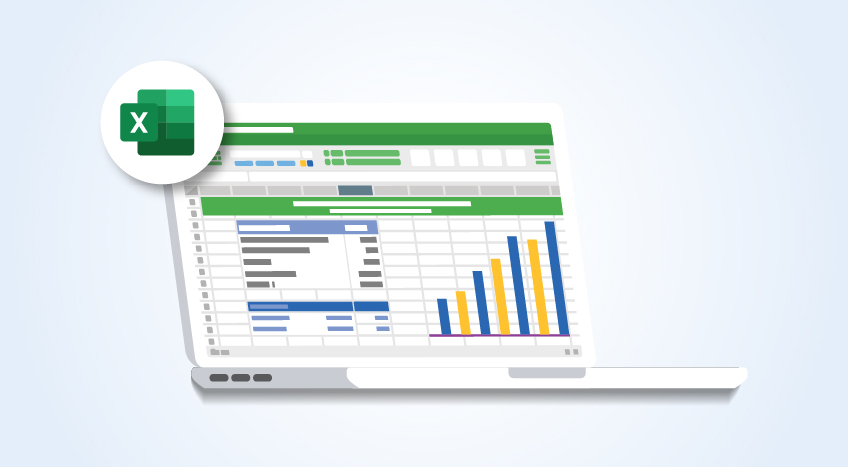Tally Solutions |Updated on: March 5, 2024
Excel spreadsheets are a ubiquitous tool used in businesses of all sizes. They are used to store and manage a wide variety of data, from customer records to financial data to inventory information and so much more. It’s the most common format used by business worldwide to share their transaction details. For example, a business receiving or downloading order/invoice details from an e-commerce operator, would be required to process the data maintained by the operator in Excel.
Unsurprisingly, even when businesses have automated their accounting and bookkeeping using business management software, there is always some data maintained in Excel.
While this as a need or practice will continue to exist. The critical question is, what happens to the data that is maintained in the Excel? The answer is simple. The relevant data needs to be recorded in the software the businesses use. Let’s say you have downloaded the Excel with details of invoices from the e-commerce operator portal. You need to record all these invoices in your accounting or business software. This needs to be done manually, which is a time-consuming process and is prone to a lot of errors, and if the volume is high, it will be a nightmare.
Is there any method to do it quickly? Yes, there is.
Directly import the Excel data to the business management software. To make this possible, the software needs to be built with the capabilities that allows you to import the ledgers and transactions from Excel. Software should create relevant records based on the information available in Excel. Just like in the case of the e-commerce operator, software should create invoices automatically upon importing the invoice details from Excel.
Before looking at the benefits of Excel import capabilities, let’s look at the scenarios in which it will be helpful.
| Import Data from Excel to TallyPrime | One-Size-Fits-None: Why Flexibility is Key in Building a Reports Dashboard in Business Management Software |
Scenarios when importing data from Excel will be useful
There are a number of scenarios when importing data from Excel can be useful. Some of the most common scenarios include:
- Received price list in Excel from the dealers: If you receive a price list from a dealer in Excel, you can import the price list into your business management software so that you can easily track and compare prices.
- Download the details of receipts and payments in Excel: If you download the details of your receipts and payments from your collection agent in Excel, you can import the data into your business management software so that you can easily record your spending and income.
- Switching from different software: If you are switching from one business management software to another, you may need to import data from your old software into your new software.
- Using more than one software: If you are using multiple software applications, such as accounting software and logistic software, you may need to import data from one software application to the other. For example, you may need to import data from your logistic software into your accounting software so that you can track your inventory costs.
- You filed staff shares the Excel data: If your field staff shares data on stock orders or payments received in Excel, you can import the data into your business management software so that you can easily track your sales and inventory.
- e-commerce platform data in Excel: If you are using an e-commerce platform, you may be able to export your order and payment data to Excel. You can then import this data into your business management software so that you can easily track your sales and payments.
Importing data from Excel: Business management software capabilities
There are a number of benefits to importing data from Excel into business management software. Some of the most common benefits include:
- Improved efficiency: Importing data from Excel can save businesses time and effort by eliminating the need to manually enter data into their business management software.
- Reduced errors: Importing data from Excel directly can help to reduce errors by eliminating the need to manually enter data.
- Improved scalability and data visibility: Importing data from Excel can make it easier for businesses to view and access their data present in multiple sheets at one centralized location. This provides the ability to import volumeness data without any hassle. It will not only be an easier option for businesses but also a scalable one. The software will automatically take the data from Excel and make it readily available irrespective of its size.
- Enhanced data analysis and reporting: By importing data into the business management software, users can utilize the tools on top of it and perform accurate analysis and reporting. Businesses can take advantage of these capabilities to gain valuable insights into their business which will also give them the competitive edge.
The new TallyPrime 4.0
The wait is over as the TallyPrime is here with much more than just excel import capability in its latest release---TallyPrime4.0.
- Got ledgers or transactions in Excel in a specific format? You can quickly import the excel file and map the information to the fields in TallyPrime
- Easily import masters and transactions kept in Excel to TallyPrime
- Sample Excel template. You may use the template of your choice or use the template provided by TallyPrime
- When importing, logs are made to record any mistakes that may have happened
And so much more…..
Latest Blogs

Nuts & Bolts of Tally Filesystem: RangeTree

A Comprehensive Guide to UDYAM Payment Rules

UDYAM MSME Registration: Financial Boon for Small Businesses

Understanding UDYAM Registration: A Comprehensive Guide

MSME Payment Rule Changes from 1st April 2024: A Quick Guide

Are Your Suppliers Registered Under MSME (UDYAM)?


